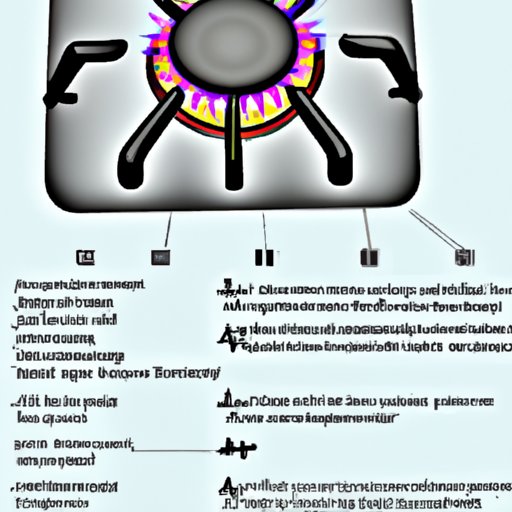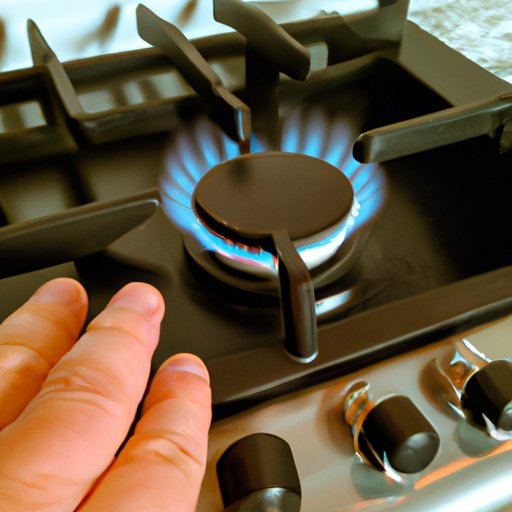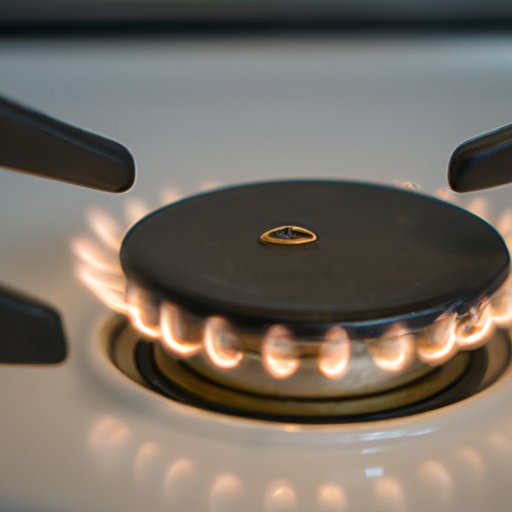Introduction
Gas stoves are an essential part of many kitchens and restaurants around the world. They provide a quick and efficient way to cook food, but they can also be dangerous if not handled properly. This article will provide a comprehensive overview of how to start a gas stove, including step-by-step instructions, tips and tricks, and expert advice on safely igniting the stove.

Definition of a Gas Stove
A gas stove is a kitchen appliance that uses natural gas or propane to heat food. It typically consists of several burners and a control panel with knobs that allow you to adjust the temperature of each burner. The gas is ignited by either a spark or a pilot light, which is then used to heat the burners.
Overview of Common Problems with Starting a Gas Stove
The most common problem people experience when trying to start a gas stove is that the gas does not ignite. This can be due to a number of factors, such as an empty gas tank, clogged burners, or faulty wiring. In addition, it’s important to make sure the stove is properly vented and that all safety precautions are followed before attempting to start it.
Step-by-Step Guide on How to Start a Gas Stove
In order to safely and successfully start a gas stove, it’s important to follow these steps:
Preparing the Gas Stove
Before attempting to start a gas stove, it’s important to ensure that the gas tank is full and that the burners are free of any debris. Additionally, check that all of the connections are secure and that the venting system is functioning properly. Finally, make sure that the room is well ventilated and that there are no flammable materials nearby.
Lighting the Gas Stove
Once the gas stove is prepared, it’s time to light it. Depending on the type of stove, this can be done with either a spark or a pilot light. If using a spark, simply turn the knob to “ignite” and press the spark button until the burner lights. If using a pilot light, turn the knob to “pilot” and hold a lit match or lighter up to the burner until it ignites.
Adjusting the Heat Settings
After the burner has been lit, it’s time to adjust the heat settings. This can be done by turning the knob to the desired setting (high, medium, low, or off). Be sure to keep an eye on the stove while cooking to ensure that it doesn’t get too hot or too cold.
A Comprehensive Overview of Lighting a Gas Stove
In addition to the steps outlined above, it’s important to understand the different types of gas stoves, identify safety precautions, and explore different ignition techniques.
Understanding Different Types of Gas Stoves
Gas stoves come in a variety of sizes and styles, from small countertop models to large commercial units. It’s important to familiarize yourself with the type of stove you have in order to ensure that you are following the correct lighting procedures.
Identifying Safety Precautions
When starting a gas stove, it’s important to take the necessary safety precautions. Make sure the area is well ventilated and that there are no flammable materials nearby. Additionally, always wear protective gear, such as oven mitts and safety glasses, when working with a gas stove.
Exploring Different Ignition Techniques
Depending on the type of gas stove, there are different techniques for lighting it. Some stoves require a spark, while others require a pilot light. It’s important to familiarize yourself with the specific technique required for your stove in order to ensure a successful ignition.
A Beginner’s Guide to Utilizing a Gas Stove
For those just getting started with using a gas stove, there are a few key points to keep in mind.
Familiarizing Yourself with the Controls
Before attempting to start a gas stove, it’s important to familiarize yourself with the controls. Understand how to adjust the temperature and how to turn the stove off in case of an emergency. Additionally, know where the shut-off valve is located in case you need to turn off the gas.
Learning Basic Maintenance Tips
Once you’ve mastered the basics of operating a gas stove, it’s important to learn some basic maintenance tips. These include regularly cleaning the burners and checking the connections for any signs of wear and tear. Additionally, it’s important to check that the venting system is functioning properly.
Discovering Alternative Uses
Finally, it’s important to explore the various ways in which a gas stove can be used. From boiling water to roasting vegetables, there are countless dishes that can be cooked on a gas stove. Additionally, gas stoves can also be used to heat up a room or dry clothes.

Tips and Tricks for Easily Starting a Gas Stove
In addition to the steps outlined above, there are some useful tips and tricks that can help make starting a gas stove easier.
Troubleshooting Common Issues
If the gas stove won’t ignite, it’s important to troubleshoot the issue. Check the connections, make sure the gas tank is full, and clean the burners. Additionally, if the stove is sparking but not lighting, it could be due to a faulty spark igniter or a clogged burner.
Utilizing Natural Methods of Ignition
If the spark igniter isn’t working, there are other methods of ignition that can be used. These include using a match or lighter to light the gas manually. However, it’s important to be extra cautious when using this method, as it can be dangerous if not done properly.
Selecting an Appropriate Flame Size
Once the stove is lit, it’s important to select an appropriate flame size. Generally, the flame should be blue and slightly flickering. If it’s yellow and roaring, adjust the knob to lower the heat. Conversely, if the flame is very low, adjust the knob to increase the heat.

An Illustrated Guide to Starting a Gas Stove
For those who prefer visual aids, an illustrated guide can be helpful in understanding the steps involved in starting a gas stove. Here are some tips for creating an effective guide:
Visual Representation of the Steps
Include visuals that clearly demonstrate each step in the process, from preparing the stove to adjusting the heat settings. Additionally, use arrows and labels to indicate which knob to turn and which buttons to press.
Diagrams Explaining the Process
In addition to visuals, diagrams can be used to explain the process in greater detail. Include diagrams that show the components of the stove, such as the burners, knobs, and spark igniters.
Illustrations Demonstrating Safety Measures
It’s also important to include illustrations that demonstrate safety measures, such as wearing protective gear and keeping flammable materials away from the stove. Additionally, include illustrations of what to do in case of an emergency, such as turning off the gas or evacuating the area.
An Expert’s Advice on How to Safely Ignite a Gas Stove
Finally, here is some expert advice on how to safely ignite a gas stove:
Professional Tips for Successfully Lighting the Stove
According to a study conducted by the National Fire Protection Association, the best way to light a gas stove is to use a spark igniter. Additionally, it’s important to make sure the connections are secure and that the venting system is functioning properly.
Best Practices for Maintaining a Gas Stove
Regular maintenance is key to ensuring that your gas stove is functioning properly. This includes regularly inspecting the connections, cleaning the burners, and checking the venting system. Additionally, never leave the stove unattended while it is in use.
Suggestions for Keeping Your Kitchen Area Safe
Finally, it’s important to practice good safety habits when using a gas stove. Make sure the area is well ventilated and that there are no flammable materials nearby. Additionally, wear protective gear, such as oven mitts and safety glasses, when cooking.
Conclusion
Starting a gas stove can be a daunting task, but with the right knowledge and preparation, it can be done safely and successfully. By following the steps outlined in this article, you can ensure that you are properly igniting your stove and avoiding any potential hazards. Additionally, understanding the different types of stoves, identifying safety precautions, and exploring different ignition techniques can help to make the process even easier.
In conclusion, starting a gas stove is a relatively simple process, provided that you follow the necessary steps and safety precautions. With a little bit of practice and patience, you can master the art of igniting a gas stove in no time.
(Note: Is this article not meeting your expectations? Do you have knowledge or insights to share? Unlock new opportunities and expand your reach by joining our authors team. Click Registration to join us and share your expertise with our readers.)
